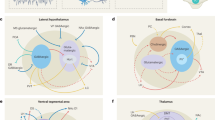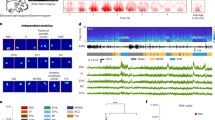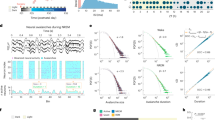Abstract
The timing of sleep and wakefulness in mammals is governed by a sleep homeostatic process and by the circadian clock of the suprachiasmatic nucleus (SCN), which has a molecular basis for rhythm generation. By combining SCN electrical activity recordings with electroencephalogram (EEG) recordings in the same animal (the Wistar rat), we discovered that changes in vigilance states are paralleled by strong changes in SCN electrophysiological activity. During rapid eye movement (REM) sleep, neuronal activity in the SCN was elevated, and during non-REM (NREM) sleep, it was lowered. We also carried out selective sleep deprivation experiments to confirm that changes in SCN electrical activity are caused by changes in vigilance state. Our results indicate that the 24-hour pattern in electrical activity that is controlled by the molecular machinery of the SCN is substantially modified by afferent information from the central nervous system.
This is a preview of subscription content, access via your institution
Access options
Subscribe to this journal
Receive 12 print issues and online access
$209.00 per year
only $17.42 per issue
Buy this article
- Purchase on SpringerLink
- Instant access to full article PDF
Prices may be subject to local taxes which are calculated during checkout





Similar content being viewed by others
References
Crick, F. & Mitchison, G. The function of dream sleep. Nature 304, 111–114 (1983).
Krueger, J.M. & Obál, F. A neuronal group theory of sleep function. J. Sleep Res. 2, 63–69 (1993).
Benington, J.H. & Heller, H.C. Restoration of brain energy metabolism as the function of sleep. Prog. Neurobiol. 45, 347–360.
Jouvet, M. Paradoxical sleep as a programming system. J. Sleep Res. 7 (Suppl. 1) 1–5 (1998).
Stickgold, R., Hobson, J.A., Fosse, R. & Fosse, M. Sleep, learning, and dreams: off-line memory reprocessing. Science 294, 1052–1057 (2001).
Borbély, A.A. & Achermann, P. Sleep homeostasis and models of sleep regulation. in Principles and Practice of Sleep Medicine 3rd edn. (eds. Kryger, M.H., Roth, T. & Dement, W.C.) 377–390 (WB Saunders, Philadelphia, 2000).
Tobler, I. & Borbély, A.A. Sleep EEG in the rat as a function of prior waking. Electroencephalogr. Clin. Neurophysiol. 64, 74–76 (1986).
Dijk, D.J., Beersma, D.G.M. & Daan, S. EEG power density during nap sleep: reflection of an hourglass measuring the duration of wakefulness. J. Biol. Rhythms 3, 207–219 (1987).
Lancel, M., Van Riezen, H. & Glatt, A. Effects of circadian phase and duration of sleep deprivation on sleep and EEG power spectra in the cat. Brain Res. 548, 206–214 (1991).
Strijkstra, A.M. & Daan, S. Dissimilarity of slow-wave activity enhancement by torpor and sleep deprivation in a hibernator. Am. J. Physiol. 275, R1110–R1117 (1998).
Huber, R., Deboer, T. & Tobler, I. Effects of sleep deprivation on sleep and EEG in three mouse strains: empirical data and simulations. Brain Res. 857, 8–19 (2000).
Deboer, T. & Tobler, I. Sleep regulation in the Djungarian hamster: comparison of the dynamics leading to the slow-wave activity increase after sleep deprivation and daily torpor. Sleep 26, 567–572 (2003).
Takahashi, J.S., Turek, F.W. & Moore, R.Y. Handbook of Behavioral Neurobiology. 12 (Kluwer Academic/Plenum, New York, 2001).
King, D.P. & Takahashi, J.S. Molecular genetics of circadian rhythms in mammals. Annu. Rev. Neurosci. 23, 713–742 (2000).
Albus, H et al. Crypotochrome-deficient mice lack circadian electrical activity in the suprachiasmatic nuclei. Curr. Biol. 12, 1130–1133 (2002).
Herzog, E.D., Takahashi, J.S. & Block, G.D. Clock controls circadian period in isolated suprachiasmatic nucleus neurons. Nat. Neurosci. 1, 708–713 (1998).
Liu, C., Weaver, D.R., Strogatz, S.H. & Reppert, S.M. Cellular construction of a circadian clock: period determination in the suprachiasmatic nuclei. Cell 91, 855–860 (1997).
Nakamura, W., Honma, S., Shirakawa, T. & Honma, K.I. Clock mutation lengthens the circadian period without damping rhythms in individual SCN neurons. Nat. Neurosci. 5, 399–400 (2002).
Schwartz, W.J., Gross, R.A. & Morton, M.T. The suprachiasmatic nuclei contain a tetrodotoxin-resistant circadian pacemaker. Proc. Natl. Acad. Sci. USA 84, 1694–1698 (1987).
Meijer, J.H., Schaap, J., Watanabe, K. & Albus, H. Multiunit activity recordings in the suprachiasmatic nucleus: in vivo versus in vitro models. Brain Res. 753, 322–327 (1997).
Meijer, J.H., Watanabe, K., Schaap, J., Albus, H. & Détári, L. Light responsiveness of the suprachiasmatic nucleus: long-term multiunit and single-unit recordings in freely moving animals. J. Neurosci. 18, 9078–9087 (1998).
Daan, S., Beersma, D.G.M. & Borbély, A.A. Timing of human sleep: recovery process gated by a circadian pacemaker. Am. J. Physiol. 246, R161–R178 (1984).
Edgar, D.M., Dement, W.C. & Fuller, C.A. Effect of SCN-lesions on sleep in squirrel monkeys: evidence for opponent processes in sleep-wake regulation. J. Neurosci. 13, 1065–1079 (1993).
Achermann, P. & Borbély, A.A. Simulation of daytime vigilance by the additional interaction of a homeostatic and a circadian process. Biol. Cybern. 71, 115–121 (1994).
Moses, J.M., Johnson, L.C., Naitoh, P. & Lubin, A. Sleep stage deprivation and total sleep loss: effects on sleep behavior. Psychophysiology 12, 141–146 (1975).
Borbély, A.A., Tobler, I. & Hanagasioglu, M. Effect of sleep deprivation on sleep and EEG power spectra in the rat. Behav. Brain Res. 14,171–182 (1984).
Dijk, D.J., Beersma, D.G.M., Daan, S., Bloem, G.M. & Van den Hoofdakker, R.H. Quantitative analysis of the effects of slow wave sleep deprivation during the first 3 h of sleep on subsequent EEG power density. Eur. Arch. Psychiatry Neurol. Sci. 236, 323–328 (1987).
Benington, J.H. & Heller, H.C. REM-sleep timing is controlled homeostatically by accumulation of REM-sleep propensity in non-REM sleep. Am. J. Physiol. 266, R1992–R2000 (1994).
Endo, T., Schwierin, B., Borbély, A.A. & Tobler, I. Selective and total sleep deprivation: effect on the sleep EEG in the rat. Psychiatry Res. 66, 97–110 (1997).
Palchykova, S., Deboer, T. & Tobler, I. Selective sleep deprivation after daily torpor in the Djungarian hamster. J. Sleep Res. 11 313–319 (2002).
Dijk, D.J. EEG slow waves and sleep spindles: windows on the sleeping brain. Behav. Brain Res. 69, 109–116 (1995).
Campbell, S. & Zulley, J. Evidence for circadian influence on human slow wave sleep during daytime sleep episodes. Psychophysiology 26, 580–585 (1989).
Dijk, D.J. & Czeisler, C.A. Contribution of the circadian pacemaker and the sleep homeostat to sleep propensity, sleep structure, electroencephalographic slow waves, and sleep spindle activity in humans. J. Neurosci. 15, 3526–3538 (1995).
Bina, K.G., Rusak, B. & Semba, K. Localization of cholinergic neurons in the forebrain and brainstem that project to the suprachiasmatic nucleus of the hypothalamus in rat. J. Comp. Neurol. 335, 295–307 (1993).
McCarley, R.W. & Massaquoi, S.G. Neurobiological structure of the revised limit cycle reciprocal interaction model of REM cycle control. J. Sleep Res. 1, 132–137 (1992).
Moore, R.Y., Halaris, A.E. & Jones, B.E. Serotonin neurons of the midbrain raphe: ascending projections. J. Comp. Neurol. 180, 417–438 (1978).
Mistlberger, R.E., Bergmann, B.M., Waldenar, W. & Rechtschaffen, A. Recovery sleep following sleep deprivation in intact and suprachiasmatic nuclei lesioned rats. Sleep 6, 217–233 (1983).
Tobler, I., Borbély, A.A. & Groos, G. The effect of sleep deprivation on sleep in rats with suprachiasmatic lesions. Neurosci. Lett. 42, 49–54 (1983).
Trachsel, L., Edgar, D.M., Seidel, W.F., Heller, H.C. & Dement, W.C. Sleep homeostasis in suprachiasmatic nuclei lesioned rats: effects of sleep deprivation and triazolam administration. Brain Res. 589, 253–261 (1992).
Dijk, D.J., Beersma, D.G.M. & Daan, S. Bright morning light advances the human circadian system without affecting NREM sleep homeostasis. Am. J. Physiol. 156, R106–R111 (1989).
Antle, M.C. & Mistlberger, R.E. Circadian clock resetting by sleep deprivation without exercise in the Syrian hamster. J. Neurosci. 20, 9326–9332 (2000).
Wisor, J.P. et al. A role for cryptochromes in sleep regulation. BMC Neurosci. 3, 20 (2002).
Franken, P., Dijk, D.J., Tobler, I. & Borbély, A.A. Sleep deprivation in the rat: effects on electroencephalogram power spectra, vigilance states, and cortical temperature. Am. J. Physiol. 261, R198–R208 (1991).
Deboer, T., Franken, P. & Tobler, I. Sleep and cortical temperature in the Djungarian hamster under baseline conditions and after sleep deprivation. J. Comp. Physiol. A 174,145–155 (1994).
Deboer, T. & Tobler, I. Vigilance state episodes and cortical temperature in the Djungarian hamster: the influence of photoperiod and ambient temperature. Pflügers Arch. 433, 23–237 (1997).
Acknowledgements
We thank W.J. Schwartz, E.R. de Kloet and P. Maquet for critical reading of the manuscript, and J.A.M. Janse and H. Duindam for technical support. This research was supported by Nederlandse Organisatie voor Wetenschappelijk Onderzoek grant 425-204-02.
Author information
Authors and Affiliations
Corresponding author
Ethics declarations
Competing interests
The authors declare no competing financial interests.
Rights and permissions
About this article
Cite this article
Deboer, T., Vansteensel, M., Détári, L. et al. Sleep states alter activity of suprachiasmatic nucleus neurons. Nat Neurosci 6, 1086–1090 (2003). https://doi.org/10.1038/nn1122
Received:
Accepted:
Published:
Issue Date:
DOI: https://doi.org/10.1038/nn1122



